Silent Sentinels and the Night of Terror
Introduction & Table of Contents
Paragraphing and layout of reprinted texts have been adjusted for ease of reading, and some minor typos have been corrected. —Blackbird editors.
| from The Sun, Jul.–Nov. 1917 From The Picket Line to Jail Court Orders Writ to Free 28 Suffs from The Hartford Courant, Aug. 1917 Miss Flanagan in "Model Prison" from The Masses, Aug.–Sept. 1917 from The New York Times, Sept. 1917 from Jailed for Freedom, Doris Stevens Featured Media |
|
We have summoned here the voices of the suffragists who stood as Silent Sentinels at the gates of the White House, urging citizens and government officials to consider the enfranchisement of women. They were subsequently arrested and sentenced to Virginia’s Occoquan Workhouse on November 14, 1917—what would become known as “The Night of Terror.”
The Silent Sentinels were a group of suffragists organized by Alice Paul who protested at the White House during the Wilson administration, from January of 1917 until June of 1919, when the Nineteenth Amendment was passed in Congress. The name refers to their method of using silence as a form of protest, wearing sashes with the National Woman’s Party colors of purple, gold, and white, while holding banners with sewn letters appealing to lawmakers to consider granting women the right to vote.
The suffragists took to quoting President Wilson’s own statements to emphasize the hypocrisy of an administration that was more concerned with democracy overseas than in its own nation:
Mr. President you say “liberty is the fundamental demand of the human spirit”
Mr. President you say “we are interested in the United States politically speaking, in nothing but human liberty”
Some banners simply stated, “Mr. President how long must women wait for liberty?” and “Democracy should begin at home.”
 |
|
| New York Pickets at the White House Gate. Appeared on the cover of The Suffragist V, January 31, 1917. |
|
Another banner, as recalled in Doris Stevens’s memoir Jailed for Freedom, published in 1920, was held by Sentinels at the gates of the White House on the occasion of a visit from Russian diplomats, reading:
To the Russian Envoys
President Wilson and Envoy Root are deceiving Russia. They say we are a democracy. Help us win a world war so that democracies may survive.
We, the women of America, tell you that America is not a democracy. Twenty million American women are denied the right to vote. President Wilson is the chief opponent of their national enfranchisement.
Help us make this nation really free. Tell our government it must liberate its people before it can claim free Russia as an ally.
During their protests, the Sentinels were harassed by bystanders and subject to arrests. The suffragists were repeatedly met with injustice from both citizens and authorities.
| “When all suffrage controversy has died away it will be the little army of women with their purple, white and gold banners, going to prison for their political freedom, that will be remembered.”
—Doris Stevens |
|
Even before the Night of Terror, Alice Paul and Lucy Burns, chief organizers for the National Woman’s Party (NWP)—along with other Silent Sentinels—had been sentenced to Occoquan. Despite marching two by two or standing on the sidewalk against the gates of the White House, they were arrested for “obstructing traffic.” The women found the workhouse unsanitary; they had one bar of soap to share, and the food frequently contained worms. Sick prisoners and healthy prisoners shared cells, and matrons reported that the bedding and prison uniforms were rarely washed. Paul and Burns began a hunger strike in protest of the conditions of the workhouse, which they considered disproportionate to the crime with which they were charged. Believing that they had been arrested for purely political reasons, they insisted that certain rights should be afforded to them. From within the prison, Lucy Burns had surreptitiously circulated a document on the rights of political prisoners, which all of the women signed from their cells.
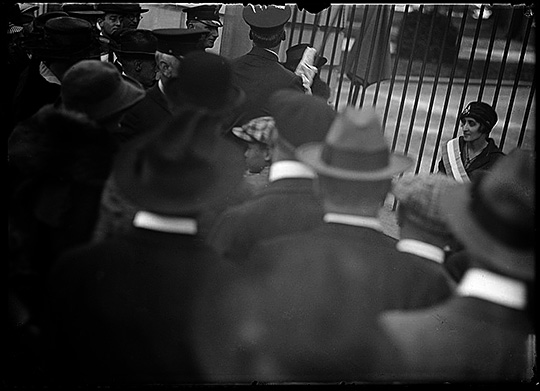 |
|
| Silent Sentinels arrested for picketing at the White House gates. Harris & Ewing Photography, Washington, D.C., 1917. |
|
On November 14, 1917, a group of suffragists was brought to Occoquan Workhouse. They were made to wait for hours before meeting with Superintendent Whittaker. When he arrived and found the women still dedicated to their cause, he ordered a mass of guards to drag the women off to their cells. They were brutalized: executive member of the National Woman’s Party, Dora Lewis, was thrown into a cell where her head struck an iron bed and she lost consciousness. Alice Cosu, who shared a cell with Dora Lewis, was so distraught at the sight of her cellmate's treatment that she suffered a heart attack later that night. Chief organizer and editor of The Suffragist, Lucy Burns, was handcuffed with her hands above her head and left that way in her cell for hours. The image of Burns behind bars at Occoquan has become an icon for the Night of Terror. Many other women also reported having been dragged, beaten, or otherwise assaulted by prison guards.
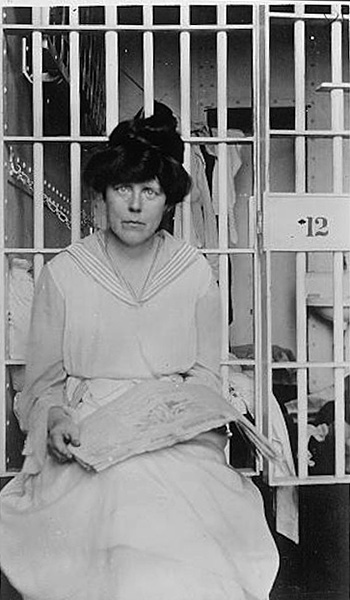 |
|
| Lucy Burns at Occoquan Workhouse Lorton, Virginia, November 1917. |
|
This collection is an assemblage of articles from the New York Times, The Masses, and other news publications, as well as firsthand accounts from the prisoners themselves, recorded in Doris Stevens’s seminal memoir, Jailed for Freedom. Doris Stevens entered into the suffrage movement as a regional organizer for the National American Woman Suffrage Association (NAWSA) and later joined the Congressional Union for Woman Suffrage (CUWS) as executive secretary.
When the CUWS became the National Woman’s Party in 1916, Stevens was an active member, and stood for months as a Silent Sentinel at the White House, undergoing several arrests before she was sentenced to Occoquan and endured the Night of Terror. Her marriage to Dudley Field Malone, an attorney and former assistant secretary of state in the Wilson cabinet before he resigned to assist the suffrage effort, was significant in that he represented the imprisoned women and fought for their release.
Stevens’s memoir is valuable documentation of the later years of the woman suffrage movement leading up to the states’ ratification of the Nineteenth Amendment to the US Constitution. The ratification occurred a year after the amendment was passed in 1919 by Congress, declaring that “the right to vote shall not be denied or abridged by the United States or by any State on account of sex.”
 |
|
| Arrest of suffragists. Harris & Ewing Photography, Washington, D.C., 1917. |
|
Our commentary on activist Dorothy Day’s account of her experience at Occoquan, as published in her 1952 memoir The Long Loneliness, emphasizes the candidly introspective glimpse Day provides into what it meant to be a political prisoner for the suffrage campaign. Dorothy Day would later earn acclaim for her efforts as part of the Catholic Worker Movement, and for her reputation as a political radical.
Other features in this suite include the American Evolution video titled “Suffragists in Virginia History.” This video mentions Richmond, Virginia suffragist Adele Goodman Clark, who was also cited in the Virginia Museum of Fine Arts Artist Profile video on photographer LeRoy Henderson, published in Blackbird v16n2. In the VMFA video, Henderson recalls working in Clark’s painting studio on Chamberlayne Avenue as a young man, learning about art and activism during his tenure with her.
In addition, we have provided a recording of Dame Ethel Smyth’s evocative composition “The March of the Women,” as performed in 1990 by the Chorus of the Plymouth Music Series. Smyth composed the march—lyrics were added afterward by Cicely Hamilton—during the British women’s suffrage movement. “The March of the Women” became the anthem of the Women’s Social and Political Union (WSPU) in the United Kingdom where suffragists sang it during marches and rallies, and the song soon became known to the American suffragists. Several sources recall that at London’s Holloway Prison in 1912, Smyth led a rendition of “The March of the Women,” conducting a group of imprisoned suffragists with a toothbrush through the bars of her cell.
~
Many of the women whose words we’ve republished here were, like Doris Stevens, members of the National Woman’s Party (NWP). Formed in 1916, it was previously a branch of the National American Woman Suffrage Association (NAWSA) known as the Congressional Union for Woman Suffrage (CUWS).
After accusations over finances and disagreements over public tactics, Alice Paul and Lucy Burns—who met in a London police station while campaigning for the British women’s suffrage movement—cut ties with NAWSA and started the National Woman’s Party to continue their efforts unrestrained. The objective of the NWP was to pass an amendment to the Constitution granting all citizens the right to vote regardless of sex. Paul and Burns also founded and circulated The Suffragist, a weekly newspaper covering the actions of the Sentinels and the inaction of Woodrow Wilson.
The Woman Suffrage Procession, the first suffrage parade held in Washington, D.C. with the approval of NAWSA, was held on March 3, 1913, the day before Woodrow Wilson’s presidential inauguration. Paul and Burns raised the funds and organized the event themselves with little help from other NAWSA branches. The procession was elaborate: nine bands, four mounted brigades, roughly twenty-four floats, and several thousand suffragists marched down Pennsylvania Avenue.
With minimal security offered by the police, the women were subject to verbal and physical harassment: they were shoved and jostled along their route, all while men shouted that they should give up and go home. But, as Doris Stevens recalls in Jailed for Freedom, “It was no longer a secret that women wanted to vote and that they wanted the President and Congress to act.” When Wilson arrived in Washington, he was greeted by a smaller crowd than he expected; people had gathered instead to watch the Woman Suffrage Procession. The suffragists considered their demonstration a success.
 |
|
| Inez Milholland Boissevain riding Gray Dawn Woman Suffrage Procession, Washington, D.C., March 3, 1913. |
|
The most iconic images of the Woman Suffrage Procession feature labor lawyer and suffragist Inez Milholland Boissevain, who had ridden into the procession on a white horse wearing a cape and crown. Her death just three years later motivated Alice Paul to establish the Silent Sentinels as a means to increase pressure on the Wilson administration. Boissevain had been diagnosed months beforehand with pernicious anemia, but refused to abandon the cause for suffrage. Her last public words were, “Mr. President, how long must women wait for liberty?” before she collapsed in the middle of a speech while campaigning in California.
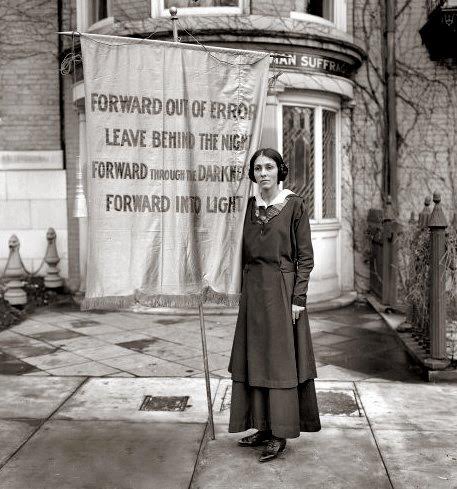 |
|
| Suffragist holding a banner at the memorial for Inez Milholland Boissevain. The words, "Forward out of error / Leave behind the night / Forward through the darkness / Forward into light," recall the first banner Boissevain ever held at a suffrage event years prior, Harris & Ewing Photography, 1916. |
|
Alice Paul was also the original writer behind the Equal Rights Amendment (ERA), proposing equal legal rights for United States citizens regardless of sex. “Men and women” Paul wrote, “shall have equal rights throughout the United States and every place subject to its jurisdiction.” The ERA was first brought to Congress in 1923 and has been introduced in every session of Congress for over fifty years, but it was never ratified by enough states to become an amendment to the Constitution. The Nevada legislature ratified the amendment in March of 2017, and Illinois ratified in May of 2018. Only one more state would be needed to ratify the ERA and amend the Constitution, but because the deadline for ratification passed nearly forty years ago, there is question as to if an impending ratification would be legal.
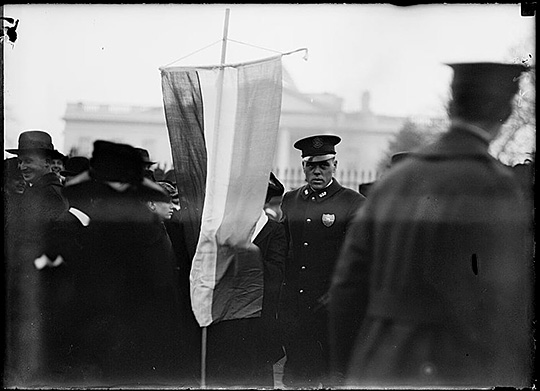 |
|
| Sentinel holding banner arrested at the White House. Harris & Ewing Photography, Washington, D.C., 1918. |
|
Though the Nineteenth Amendment finally passed in 1920, granting all women the right to vote, poll taxes and literacy tests effectively sustained the disenfranchisement of women of color in southern states until the Voting Rights Act of 1965. While many white suffragists withstood all manner of weather, mockery, and imprisonment for their cause, they did not conceive of the same rights for all women. The materials we have compiled include their prejudices, which are all the more startling in the context of their impassioned fight for equality and political freedom. Accounts mention their disregard for the women of color with whom they were imprisoned at Occoquan, as well as their outrage in response to the integration of the workhouse.
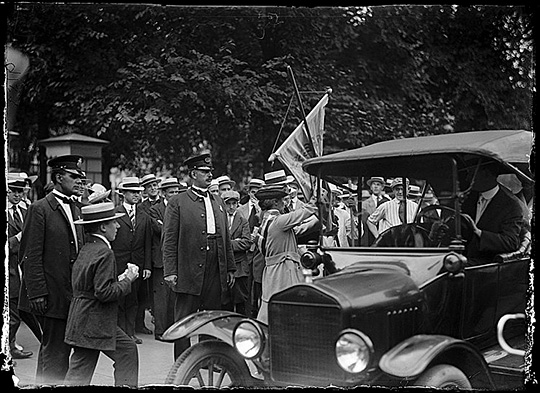 |
|
| Sentinels arrested at the White House and loaded into police car. Harris & Ewing Photography, Washington, D.C., 1917. |
|
The narratives of the Silent Sentinels align closely with the contemporary zeitgeist. Though their efforts led to the passage of the Nineteenth Amendment in 1920, they were aware that legitimizing women’s political freedom would be an ongoing concern. Alice Paul’s authorship of the ERA was another effort toward the acknowledgment of women’s equality under the law. Many actions were made in support of women’s equality, with many more to follow. Doris Stevens writes in Jailed for Freedom:
Our objective was the national enfranchisement of women. A tiny step, you may say. True! But so long as we know that this is but the first step in the long struggle of women for political, economic and social emancipation, we need not be disturbed . . . That women have been aroused never again to be content with their subjection there can be no doubt. That they will ultimately secure for themselves equal power and responsibility in whatever system of government is evolved is positive. How revolutionary will be the changes when women get this power and responsibility no one can adequately foretell. One thing is certain. They will not go back. They will never again be good and willing slaves.
It has been a long, wearying struggle. . . . To be sure, women have often resented it deeply that so much human energy had to be expended for so simple a right. But whatever disillusionments they have experienced, they have kept their faith in women.
~
More than one hundred years after the Woman Suffrage Procession of 1913 in Washington, D.C., an estimated five million people participated in the 2017 Women’s March on Washington and in sister marches all over the world, which reached every continent. The majority of the protesters were women marching in response to the impending Trump administration and the threat it posed to women’s rights—reproductive rights, racial equality, LGBTQ+ rights, health-care reform, worker’s rights, immigration reform, environmental protection, and freedom of religion, among others. The closing sentence in the mission statement for the Women’s March organization states:
Women’s March is committed to dismantling systems of oppression through nonviolent resistance and building inclusive structures guided by self-determination, dignity and respect.
Much like the Woman Suffrage Procession of 1913, the march was held within days of the inauguration of a president whose platform discounted women’s rights. The Women’s March of 2017 was the largest nonviolent protest in US history.
No arrests were made. ![]()
1917 Suite: A Month, a Year, a Term of Liberty
Introduction & Cross-issue Table of Contents